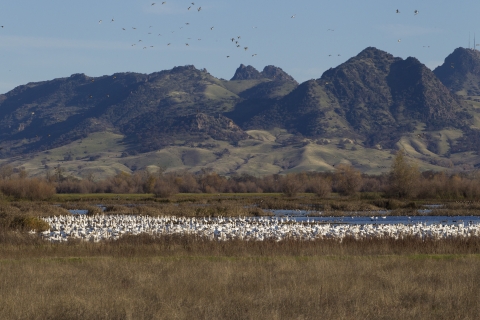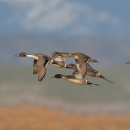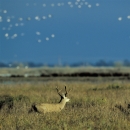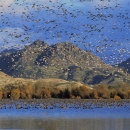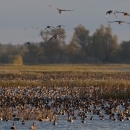About Us
The Butte Sink Wildlife Management area was established in 1979 with the primary purpose of preserving native wetland habitat to perpetuate the migratory waterfowl resource in the Central Valley and the Pacific Flyway. It has an acquisition boundary which includes parts of Butte, Colusa and Sutter counties (click here to see a map). It includes 32 conservation easements on approximately 10,311 acres of privately-owned wetlands, but also includes the 733 acre fee-title property known as the Butte Sink Unit.
Managed wetlands comprise the majority of the WMA and consist primarily of seasonal wetlands with fewer semi-permanent and permanent wetlands. The wetlands occur in a floodplain and are characterized by a strong riparian riparian
Definition of riparian habitat or riparian areas.
Learn more about riparian forest and emergent vegetation component. Butte Creek and its tributaries meander through the WMA providing a water source for many of the wetlands. The Butte Sink WMA represents the largest contiguous block of wetlands in the Sacramento Valley and typically supports up to 2 million wintering waterfowl and large numbers of the State-listed as threatened greater sandhill crane. These wetlands also support significant populations of breeding herons, egrets, and other waterbirds. Butte Creek and its associated wetlands also support anadromous fish, including federally threatened spring-run Chinook salmon and Central Valley steelhead.
The Butte Sink Unit was established in 1980 as part of the Butte Sink Wildlife Management Area. This unit lies between the Sacramento River and the Sutter Buttes, and is bounded on its west side by Butte Creek.
The Butte Sink Unit also supports large populations of wintering waterfowl, with peak populations historically reaching up to one million birds. Because the easement properties of the Butte Sink WMA are under private ownership, public access is not permitted. Due to its isolated location and difficult access, the Butte Sink Unit is closed to public use.
Managed wetlands comprise the majority of the total acreage, and consist mostly of seasonally flooded wetlands, with occasional semi-permanent wetlands. The remaining acreage is comprised of grasslands and riparian forest habitats. The Butte Sink Unit can host wintering waterfowl in excess of 500,000 ducks and 40,000 geese, occasionally reaching a peak population of over one million birds. Aside from wintering waterfowl, the unit supports other species such as bald eagle, greater sandhill cranes, California quail, deer, shorebirds, and an abundance of raptors such as red-tailed hawks and great-horned owls.
No public use is allowed on the Butte Sink Unit, in accordance with deed restrictions.
Our Mission
The mission of the National Wildlife Refuge System is to administer a national network of lands and waters for the conservation, management and, where appropriate, restoration of the fish, wildlife and plant resources and their habitats within the United States for the benefit of present and future generations of Americans.
Other Facilities in this Complex
Butte Sink Wildlife Management Area is managed as part of the Sacramento National Wildlife Refuge Complex, with headquarters at Sacramento National Wildlife Refuge. The Refuge Complex is comprised of 5 National Wildlife Refuges (Sacramento, Delevan, Colusa, Sutter and Sacramento River NWRs) and 3 Wildlife Management Areas (Willow Creek-Lurline, Butte Sink and Steve Thompson North Central Valley WMAs).

